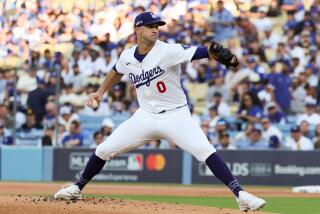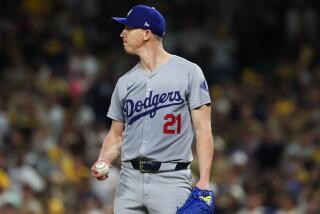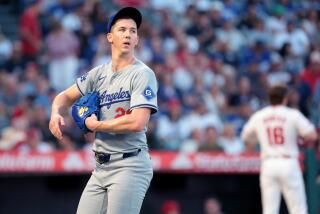Pena’s Season of Quiet Desperation Can Stop With a Start in Cincinnati
- Share via
ATLANTA — To every thing, there is a season, but for some, it just comes later than for others.
And tonight in Cincinnati, five months later than his teammates but sooner than many had dared to hope, the season has come for Alejandro Pena to pitch again.
The Dodger pitcher who takes the mound against the Reds in the second game of a doubleheader tonight will not be the Pena of old, the right-hander who had the lowest earned-run average (2.48) in the National League last season.
That was the Pena of the 94-m.p.h. fastball, the Pena “who was just totally in command,” as Candy Maldonado described him.
“He was so calm, and then the ball came at you like a cannonball,” Maldonado said.
The cannon that is Pena’s right shoulder has been stripped away, ravaged by the strain of throwing a baseball harder than nature says you should.
But what baseball has torn asunder, Pena--with the help of physical therapist Pat Screnar--has labored for months to repair. How far the 26-year-old Dominican has come, no one knows just yet.
“This is new territory for everybody,” trainer Bill Buhler said Thursday night.
But when asked if everyone would be holding his breath tonight, Buhler shook his head.
“He (Pena) isn’t,” Buhler said. “It’s just a start for him, that’s all.”
A start, in the sense of Pena’s first turn in the rotation since last September 19, when he lasted just four innings in Atlanta. A start, too, in the sense of a new beginning, an end to what has been a season of quiet desperation.
“Every day has been frustrating for him,” said pitching coach Ron Perranoski, who has done his best to nurture faith where there had been little.
“I told him I know how frustrating it is, and he’s doing a hell of a job.”
Pena underwent arthroscopic surgery--a common procedure for elbows and knees, still a relatively new technique for shoulders--just before the start of spring training in February and had been on the disabled list since opening day. In many ways, he has been a Dodger in uniform only.
“It’s tough to stay in uniform and just sit there,” said pitcher Bobby Castillo, who missed almost an entire season in Minnesota after suffering a rotator-cuff injury.
“He’d like so much to be a part of this, but there’s not much he can do. He goes out shagging (fly balls) with us, but that’s about the only time he’s having fun.”
On the road, Pena said, it’s even harder.
“I sit in the hotel by myself a lot and watch television,” he said.
But while his teammates have been playing, Pena has been working under the supervision of Screnar, lifting weights, working on the Nautilus and Cybex machines, and undergoing electrical stimulation to rebuild his shoulder. Buhler said some of the cartilage can regenerate, although it will never be as strong as it was.
“His shoulder was quite unstable because of the pain,” Screnar said. “It’s gradually getting more stable.”
The pain has not gone away, but at least it has subsided to the point where Pena was able to pitch in two simulated games, one last weekend, when the decision was made to activate him.
“He threw the ball well,” Manager Tom Lasorda said. “His arm feels good, and that’s the important thing.”
When Dr. Frank Jobe, the Dodger team physician, examined the inside of Pena’s shoulder with an arthroscope last February, he was startled by the amount of damage that had been done to the labrum, the area of cartilage that is located at the rim of the shoulder socket.
The cartilage had been worn away in both the front and the back, Jobe said, and the biceps tendon looked like it had been pounded.
At the time, Jobe couldn’t be sure whether another operation would be needed. He couldn’t be sure if Pena would pitch again.
“Hopefully, he can come back and throw other types of pitches besides the fastball,” Jobe said.
First, though, Pena had to be content with playing catch. Then, gradually, he started throwing from a mound, first for 10 minutes, then longer.
Initially, his fastball would have been ticketed for loitering, but as the shoulder gained strength and he tore through the adhesions, his velocity increased. It’s not to where it was, though. Perranoski said he was throwing in the mid-80’s last weekend. But just how far he has progressed won’t be known until he pitches in a game.
“He’s done so much to get himself to this point,” Perranoski said. “The next step will be where the mental aspect comes in--because the pain will be there.”
For Pena, the worst hurt would be if he couldn’t pitch, at all.
“I don’t think about not coming back,” he said.
For now, neither do the Dodgers. For them, as for Pena, it is the season of hope.
“A lot of people crossed off Tommy John after his operation,” Buhler said. “And what has he pitched, another 10 years?”
More to Read
Go beyond the scoreboard
Get the latest on L.A.'s teams in the daily Sports Report newsletter.
You may occasionally receive promotional content from the Los Angeles Times.










